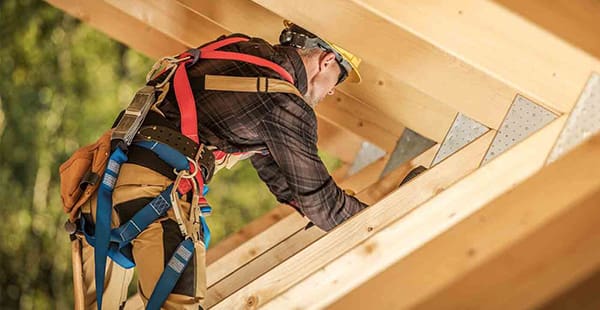01. Asbestos Risk
How Are Construction Workers Exposed to Asbestos?
Construction workers may have handled asbestos materials while working. In the past, many building materials contained asbestos because of its durability and heat resistance. These asbestos products could be found in homes and other structures until the 1980s. Some of those buildings may still have these products.
Remodeling or repairing older structures may disturb asbestos products. No matter the source, asbestos exposure carries health risks. It can cause mesothelioma and other serious illnesses.
Asbestos construction materials can become dangerous as they get older. Damaged or crumbling asbestos products can release harmful fibers into the air. Airborne asbestos can be easily inhaled or ingested. When this happens, workers may develop asbestosis, lung cancer or malignant mesothelioma.
Current laws and regulations limit asbestos use in the United States. However, construction workers may still have an elevated risk of occupational exposure.
What Asbestos Products Put Construction Workers at Risk?
The durability and fire resistance of asbestos made it popular for use in buildings, homes and schools. Asbestos construction products put installers and building occupants at risk.
Exposure may happen by cutting or sanding asbestos materials. The dangerous fibers can also be released during remodeling projects in older buildings. Construction workers may have been exposed to asbestos from:
- Ceiling tiles
- Cement
- Drywall
- Insulation
- Joint packing
- Paint
- Plaster
- Popcorn ceilings
- Roofing materials
- Vinyl floor tiles
Many companies manufactured and sold asbestos products that put workers at risk. The military, government and other organizations often used these materials.
Common Places Construction Workers May Find Asbestos
Construction workers used many asbestos-containing materials at various work sites until the 1980s. These asbestos jobsites put workers at risk of exposure during construction. Some of these materials may still pose a threat in older buildings today.
Locations where construction workers have been exposed to asbestos include:
Many products within these buildings may have asbestos. Drywall, floor tiles, paint and roofing products were all made with asbestos in the past.
Asbestos abatement professionals have removed asbestos from many buildings since the 1980s. But thousands of structures may still contain the dangerous mineral. These lingering asbestos products mean construction workers remain at high risk of exposure.
Construction Workers and At-Risk Trades
Asbestos exposure affected many professionals in the construction industry. Anyone who handled the materials or worked near asbestos dust may have been exposed. Some at-risk trades in the construction industry include:
- Bricklayers
- Carpenters
- Drywall tapers
- Electricians
- Electric power linemen
- Insulators
- Machine operators
- Painters
- Pipefitters
- Plasterers
- Plumbers
- Roofers
- Sawyers
- Stonemasons
Construction workers may have accidentally brought asbestos fibers home on their clothes and hair. This type of exposure is called secondary exposure. It can put household members at risk from the transported fibers.
02. Mesothelioma Risk
Mesothelioma Risk for Construction Workers
Construction workers are among the most at-risk occupations for asbestos exposure. Any amount of exposure may lead to asbestos-related diseases, including mesothelioma.
Researchers have examined the effects asbestos has had on the construction industry. One Italian study examined more than 31,000 mesothelioma cases. The results showed 2,310 cases were caused by asbestos exposure from construction work. 65% of all construction job types in the study had certainly been exposed to asbestos.
Mesothelioma has a long latency period, meaning it can take 10 – 50 years for symptoms to show up. Construction workers should share any prior asbestos exposure with their doctors. This can facilitate an accurate diagnosis if worrisome symptoms arise in the future.
03. Compensation
Compensation for Construction Workers With Occupational Asbestos Exposure
Construction workers who develop an asbestos-related disease can seek compensation. An asbestos lawsuit may end with a verdict or settlement. But asbestos victims might also be able to file a claim with an asbestos trust fund.
Compensation can help pay mesothelioma treatment costs, loss of income and other expenses. An experienced asbestos attorney can explain all available options. A successful lawsuit may result in a large financial award.
For example, a construction worker’s family filed a wrongful death lawsuit in 2013. The man had worked in construction for 45 years as a drywall installer. He hung wallboards and sanded joint compound to smooth the seams. He later developed peritoneal mesothelioma. A jury verdict awarded the family nearly $2.1 million.
04. Asbestos Safety
Asbestos Safety for Construction Workers
Many regulations are intended to protect construction workers from asbestos exposure. For example, the Occupational Safety and Health Administration (OSHA) and EPA set and enforce asbestos regulations.
OSHA’s regulations set permissible exposure limits (PEL) for employees. Precautions that aim to protect workers from asbestos hazards include:
- Designated decontamination and lunch areas
- Engineering controls and work practices to limit exposure, such as protective equipment
- Medical surveillance for those exposed to levels at or above the PEL
- Proper hazard communication and area identification
- Proper recordkeeping of both potential exposures and any related employee medical surveillance
Recently, the EPA has gotten closer to banning asbestos use in the United States. But older buildings may still contain materials that pose exposure risks.




